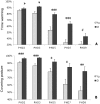Age affects the expression of maternal care and subsequent behavioural development of offspring in a precocial bird
- PMID: 22701515
- PMCID: PMC3365116
- DOI: 10.1371/journal.pone.0036835
Age affects the expression of maternal care and subsequent behavioural development of offspring in a precocial bird
Abstract
Variations of breeding success with age have been studied largely in iteroparous species and particularly in birds: survival of offspring increases with parental age until senescence. Nevertheless, these results are from observations of free-living individuals and therefore, it remains impossible to determine whether these variations result from parental investment or efficiency or both, and whether these variations occur during the prenatal or the postnatal stage or during both. Our study aimed first, to determine whether age had an impact on the expression of maternal breeding care by comparing inexperienced female birds of two different ages, and second, to define how these potential differences impact chicks' growth and behavioural development. We made 22 2-month-old and 22 8-month-old female Japanese quail foster 1-day-old chicks. We observed their maternal behaviour until the chicks were 11 days old and then tested these chicks after separation from their mothers. Several behavioural tests estimated their fearfulness and their sociality. We observed first that a longer induction was required for young females to express maternal behaviour. Subsequently as many young females as elder females expressed maternal behaviour, but young females warmed chicks less, expressed less covering postures and rejected their chicks more. Chicks brooded by elder females presented higher growth rates and more fearfulness and sociality. Our results reveal that maternal investment increased with age independently of maternal experience, suggesting modification of hormone levels implied in maternal behaviour. Isolated effects of maternal experience should now be assessed in females of the same age. In addition, our results show, for first time in birds, that variations in maternal care directly induce important differences in the behavioural development of chicks. Finally, our results confirm that Japanese quail remains a great laboratory model of avian maternal behaviour and that the way we sample maternal behaviour is highly productive.
Conflict of interest statement
Figures



References
-
- Levine L, Coll CTG, Oh W. Determinants of Mother-Infant Interaction in Adolescent Mothers. Pediatrics. 1985;75:23–29. - PubMed
-
- Krpan K, Coombs R, Zinga D, Steiner W, Fleming A. Experiential and hormonal correlates of maternal behavior in teen and adult mothers. HORMONES AND BEHAVIOR. 2005;47:112–122. doi: 10.1016/j.bhyeh.2004.08.006. - DOI - PubMed
-
- Chiu S, Wise PM. Prolactin receptor gene expression in specific hypothalamic nuclei increases with age. The Journals of Gerontology Series A: Biological Sciences and Medical Sciences. 1996;51:B220. - PubMed
-
- Angelier F, Shaffer S, Weimerskirch H, Chastel O. Effect of age, breeding experience and senescence on corticosterone and prolactin levels in a long-lived seabird: The wandering albatross. GENERAL AND COMPARATIVE ENDOCRINOLOGY. 2006;149:1–9. doi: 10.1016/j.ygcen.2006.04.006. - DOI - PubMed
-
- Angelier F, Weimerskirch H, Dano S, Chastel O. Age, experience and reproductive performance in a long-lived bird: a hormonal perspective. BEHAVIORAL ECOLOGY AND SOCIOBIOLOGY. 2007;61:611–621. doi: 10.1007/s00265-006-0290-1. - DOI
Publication types
MeSH terms
LinkOut - more resources
Full Text Sources
Medical

